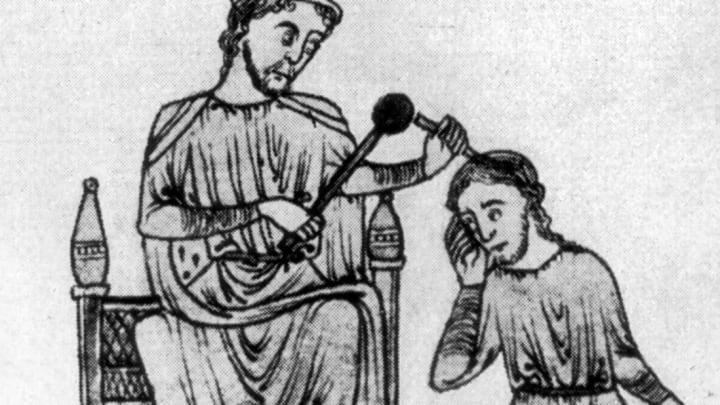Since the late nineteenth century, analgesic drugs have been available to the masses to alleviate general pain, including that caused by headaches. While that might not always do the trick, it sounds a lot better than these alternative treatments from history.
1. Burn your head
Naturally, if your brain feels like it might explode out of your skull, the thing to do is add more fire. That’s what Arateus of Cappadocia, an ancient Greek physician, recommended. Hilariously, Arateus notes that his suggestions might just be “hazardous treatments”:
[S]have off the hair (which yet on its own is good for the head) and cauterize [burn] superficially down to the muscles. If you wish to cauterize down to the bone, carry it out at a site where there are no muscles. For if you burn muscles, you will provoke cramps. Some physicians incise down to the bone on the forehead along the border of the hair. They abrade or chisel the bone down to the diploe and let flesh grow over the place. Others perforate the bone down to the meninges. These are hazardous treatments. You have to apply them when the headache persists after all that has been done; the patient keeps courage and the body is vigorous.
2. Put a dead mole on it
Praise be for Ali ibn Isa al-Kahhal (“the oculist”), who managed to bring medicine forward several hundred years through his work. Ibn Isa was—back in the 10th century—the first physician to discover the symptoms that sufferers of Vogt-Koyanagi-Harada syndrome, an eye disease, would regularly present. And though he was in many ways a smart man ahead of his time, the lack of certainty in medicine at the time meant that ibn Isa was a little wide of the mark sometimes. It was for that reason he could say with a straight face that the best way to head off those pangs of pain was to lash a dead mole to your head. Problem solved.
3. Run a warm, sweet bath
Moses Maimonides was a 12th century physician and astronomer born in Cordoba. And because headaches are as old as time immemorial, even back then people came to Maimonides complaining of head pain. His cure was unconventional, but didn’t involve dead moles or worse: immerse yourself in a bath of warm, sweetened water (honey was best), which acts to draw out the vapours that bring aches to one’s head. Truthfully, it’s not terrible advice—plenty of people after a hard day, possibly feeling fuzzy in the head, will run a bath and soak in it for several hours.
4. Add some eels to the bath
Electricity and the brain do not mix all that well, truth be told. Yet for centuries now, electricity and the brain have been mixed through medicine. (Electroshock treatment is just one example.) The Dutch Society of Sciences published a set of treatises in 1762, contained within which is a scene reported from South America espousing the benefits of electric eels in easing brain pain:
When a slave complains of a bad headache, he has them put one of their hands on their head and the other on the fish, and they thereby will be helped immediately, without exception.
Hear that? Without exception.
5. Trepanning
Ah, the age-old act of trepanning: so popular that it achieved a resurgence as a headache treatment 2500 years after it first appeared. The cavemen around in the 8th century BC put holes in their skulls to alleviate pressure on the brain (without a care for the damage they were doing to their bodies). The treatment never properly went away, but it did fall out of fashion.
Until the 1600s. Suddenly, trepanation was everywhere! Trepanning happened hither and thither, great holes being bored into brain-bearing skulls to prevent pain. If only they’d had the ability to pop some pills, an awful lot of suffering and exposure to infection could have been avoided.
